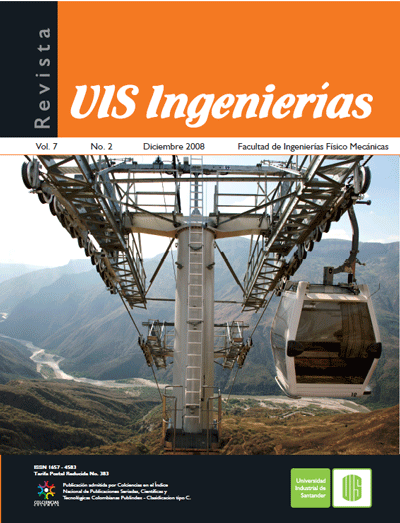Process of decomposition of the vegetal residues of the industrial university of santander by composting
Published 2008-12-03
Keywords
- Vegetable residuals,
- wormcompost,
- lignin degradation,
- cellulose degradation,
- oxygenic microorganism
How to Cite
Abstract
The vegetable lignocellulosic residues of the Universidad Industrial de Santander campus were physical, chemistry and microbiological characterized and biodegraded for wormcompost production. They were studied the effect of some variables such us air circulation and microorganism addition. These microorganisms were native acceleration products. The lignin and humins reduction presented significant differences. The biodegradation process generates more humic and fulvic acids when the vegetable residues were treated with air (overturning) and with microorganisms addition. Additionally, it was observed strong pathogenic microorganisms reduction, with pH increase, improvement of the plasticity and a regulating effect of the nutrients in the soil. In taking account the results from pilot plant, we had building a compost plant with 51 m3 of capacity.
Downloads
References
F. Zabala; A. Lozano; M. Carreño. Tratamiento biológico de los residuos vegetales de la Universidad Industrial de Santander utilizando microorganismos aceleradores y lombriz roja californiana para producir un bioabono mejorado. Tesis (Pregrado). Universidad Industrial de Santander., Bucaramanga, 2008.
G.A. Corredor. Deslignifcación del residuo fbroso del fruto de la palma africana con Coprinus niveus por fermentación en estado sólido. Tesis (Maestría Microbiología). Universidad Pontifcia Javeriana y Universidad Industrial de Santander. Bucaramanga, 2002.
B. Vinneras et all. Termal composting of local matter as treatment and possible disinfection. Method laboratory Scale and Pilot-scale studies. Bioresource Technology. vol.88, pp 47-54
A.B. Garcia- Gomez, M.P. Bernal and A. Rong. Organic mater fraction Involved in degradation and humifcation processes during composting. Compost science and utilization. Vol.13,2005. pp 127-135
Emison. El reciclado. Disponible en: http://www.emison.com/5051.htm
I.Wu; L.Q.Ma and G, A. Martínez. Comparison of methods for evaluating stability and maturity of biosolids compost. Journal of environmental quality 29 (2), 2000, pp.424-429.
C. Mondinni et all Evaluation of Extracted Organic carbon and Microbial Biomasa as Stability parameters in lignocellulosic waste compost. Journal of Environmental Quality. vol. 35, N°6, 2006, pp.2313-2320.
Z. Gómez. Abonos orgánicos. Universidad Nacional de Colombia, 2000.
D. Blanco. La materia orgánica y el humus en la agricultura sostenible. Sephu. Zaragoza, España, 1994. p51.
J.L Cadavid; J.V. Vega y M.F. Silva; Métodos analíticos del laboratorio de suelos. IT-6; Instituto Geográfco Agustín Codazzi. Departamento Agrológico segunda edición. 1963. Bogotá pp 3-6.
C.G. León Manual de análisis de suelos agrícolas. Secretaría de agricultura – Universidad Industrial de Santander. Bucaramanga, 1995.
Z.H. Valencia. Manual de Prácticas de microbiología de suelo. Universidad Nacional de Colombia. Facultad de ciencias. Santa fe de Bogota, 1996.
A.N. G’lazer and H. Nikaido. Microbial biotechnology. Fundamentals of Applied
M.T. Madigan y otros Biología de los microorganismos, 8 edición. Ed. Prentice may. España, 1998. p.p. 57- 434, 518, 576.
G.I. Beltrán obtención de biocompost a partir de tres variedades de yuca (Armrnia, Chile y amarga), usando el proceso oxigénico. Universidad Industrial de Santander. Facultad de Ciencias. Escuela de Química. Bucaramanga. 2003 p.p. 28, 59, 72.
M. Shah et all. Microbial degradation of banana waste under solid state bioprocessing using two lignocellulolytic fungi (Phylosticta spp. MPS- 001 and Aspergillus spp. Mps- 002). Process Biochemistry 2005. 40: 445-451.
B.E. Lechner and V:L Papinutt 1. Production of Lignocellulosic enzymes during growth and fruiting of the fungus Lentinus tigrimus on wheat straw. Process Biochemistry 206, pp. 594-598.
Tappi Standard of tecnical Association of the pulp and paper Industry. T. 222 om-88 Lingina; T.201 om-2000 Cellulose in pulp; T6-om-2000 Alcohol-benzene solubility of wood; T9-om-2000, Hollocellulose in Eood.
A.B. García- Gomez, M:P: Bernal and A. Rong. Organic mater fraction Involved in degradation and humifcation processes during composting. Compost science and utilization. Vol.13, 2005. p.p. 127-135.
D.C. Montgomery. Diseño y análisis de experimentos. Segunda edición; Limusa Wiley, 2005, pp. 96-123,219.
G.E. Box, W.G’. Hunter y J.S Hunger. Introducción al diseño de experimentos, análisis de datos y construcción de modelos. Ed. Reverte, 1993, pp. 317-324.

